Quantifying the Long-Term Performance of Rainwater Harvesting in Cyclades, Greece
Abstract
:1. Introduction
2. Materials and Methods
2.1. Study Area
2.2. Climatic Model
2.3. Data Description and Processing
2.4. Water Scarcity Index
3. Results
3.1. Drought Duration and Severity
3.2. Regional Rainwater Harvesting Performance
3.3. Water Availability per Capita
3.4. Effect of Tourism
4. Conclusions
Author Contributions
Funding
Data Availability Statement
Conflicts of Interest
Appendix A
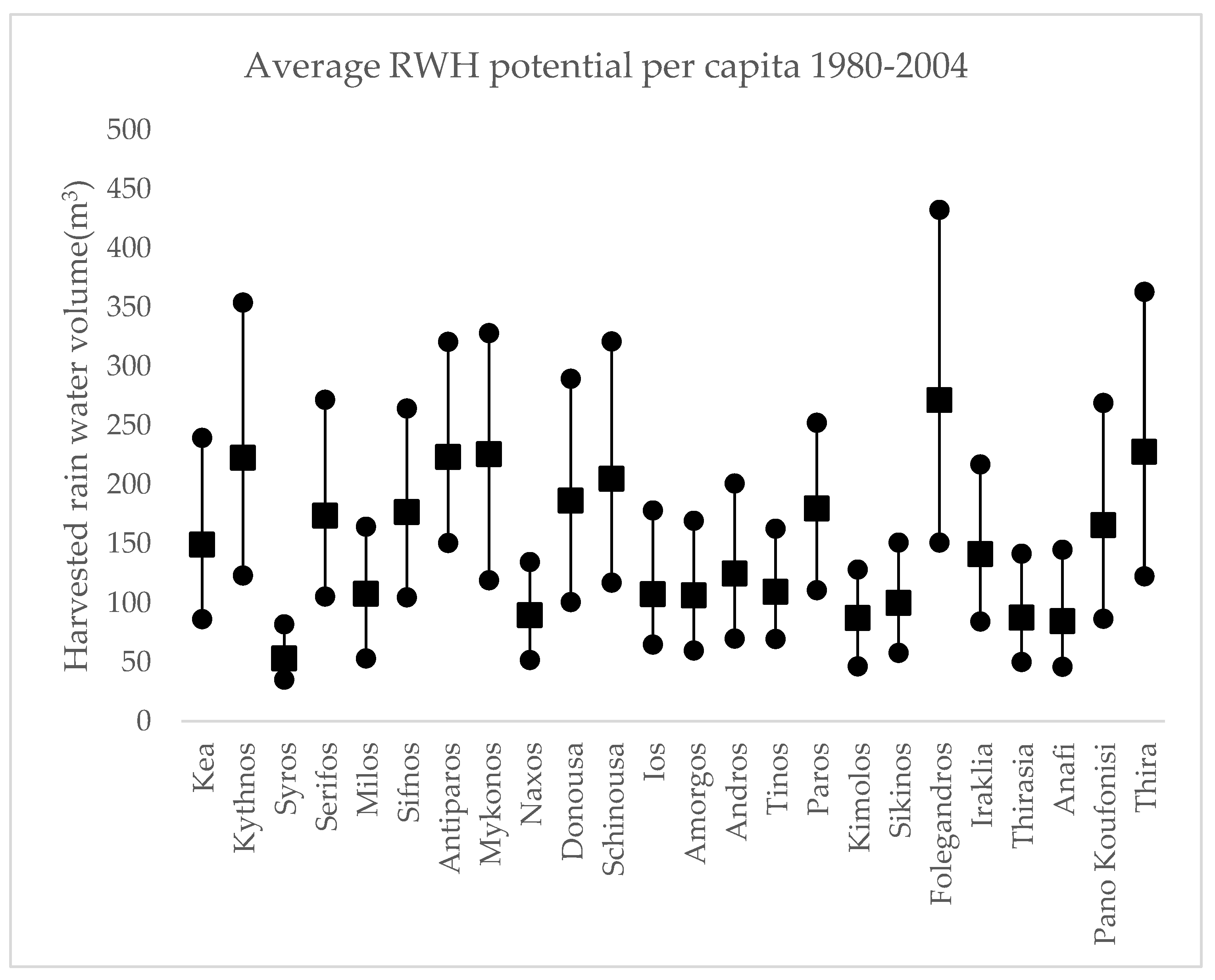
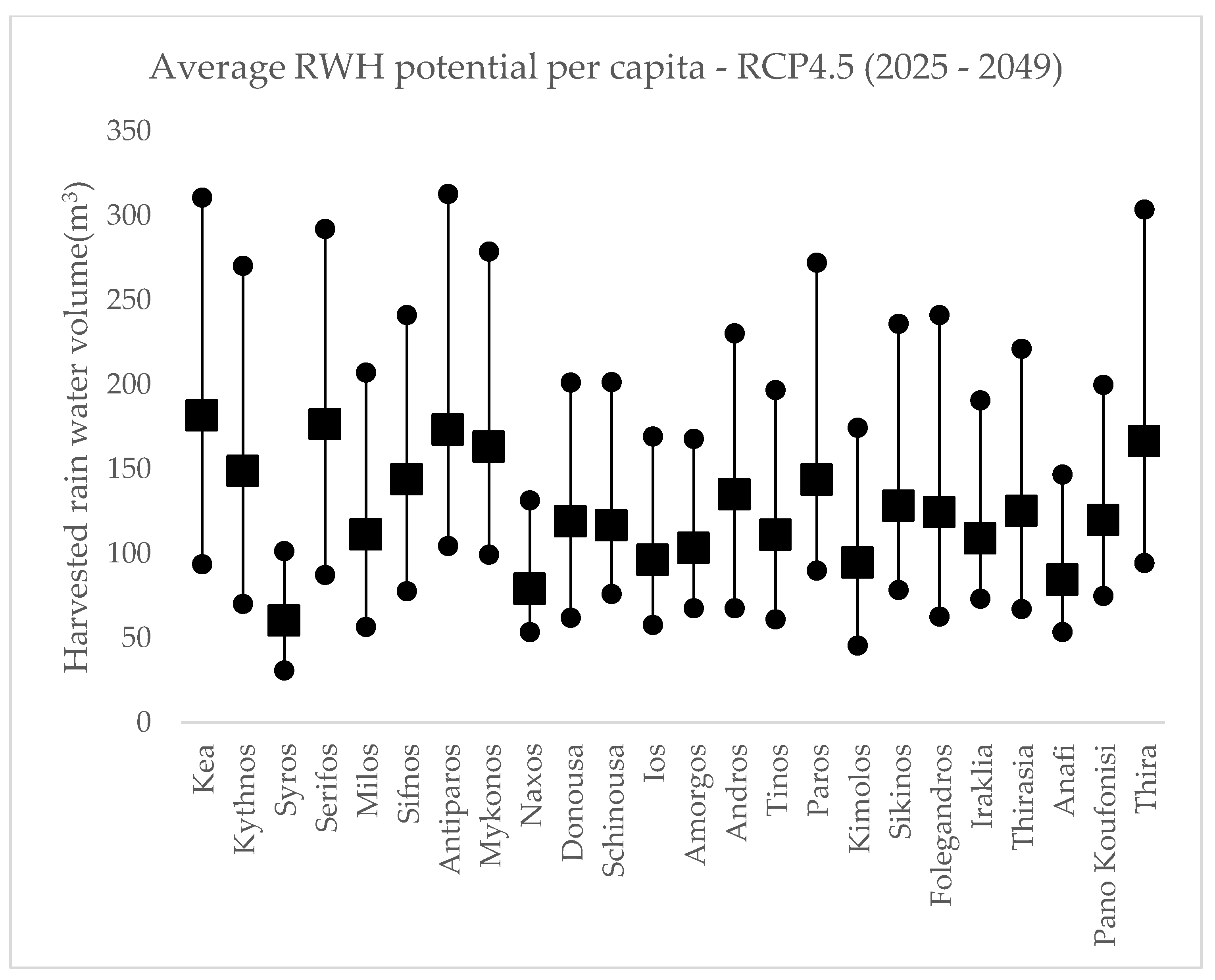



References
- Ali, E.; Cramer, W. CCP 4 Mediterranean Region; IPCC: Geneva, Switzerland, 2022; ISBN 9781009325844. [Google Scholar]
- Arndt, D.S.; Baringer, M.O.; Johnson, M.R.; Alexander, L.V.; Diamond, H.J.; Fogt, R.L.; Levy, J.M.; Richter-Menge, J.; Thorne, P.W.; Vincent, L.A.; et al. State of the climate in 2009. Bull. Am. Meteorol. Soc. 2010, 91, s1–s222. [Google Scholar] [CrossRef]
- Spinoni, J.; Vogt, J.V.; Naumann, G.; Barbosa, P.; Dosio, A. Will drought events become more frequent and severe in Europe? Int. J. Climatol. 2018, 38, 1718–1736. [Google Scholar] [CrossRef]
- Grillakis, M.G. Increase in severe and extreme soil moisture droughts for Europe under climate change. Sci. Total Environ. 2019, 660, 1245–1255. [Google Scholar] [CrossRef]
- Seneviratne, S.; Nicholls, N.; Easterling, D.; Goodess, C.; Kanae, S.; Kossin, J.; Luo, Y.; Marengo, J.; McInnes, K.; Rahimi, M.; et al. Changes in Climate Extremes and Their Impacts on the Natural Physical Environment; Cambridge University Press: Cambridge, UK, 2012; pp. 109–230. [Google Scholar] [CrossRef]
- Stathi, E.; Kastridis, A.; Myronidis, D. Analysis of Hydrometeorological Trends and Drought Severity in Water-Demanding Mediterranean Islands under Climate Change Conditions. Climate 2023, 11, 106. [Google Scholar] [CrossRef]
- Toreti, A.; Bavera, D.; Cammalleri, C.; Cota, T.; De Jager, A.; Deus, R.; Di Ciollo, C.; Maetens, W.; Magni, D.; Masante, D.; et al. GDO Analytical Report—Drought in Western Mediterranean February 2022 GDO; Publications Office of the European Union: Luxembourg, 2022; ISBN 978-92-76-49493-5. [Google Scholar]
- Rocha, J.; Carvalho-Santos, C.; Diogo, P.; Beça, P.; Keizer, J.J.; Nunes, J.P. Impacts of climate change on reservoir water availability, quality and irrigation needs in a water scarce Mediterranean region (southern Portugal). Sci. Total Environ. 2020, 736, 139477. [Google Scholar] [CrossRef]
- Ertop, H.; Kocięcka, J.; Atilgan, A.; Liberacki, D.; Niemiec, M.; Rolbiecki, R. The Importance of Rainwater Harvesting and Its Usage Possibilities: Antalya Example (Turkey). Water 2023, 15, 2194. [Google Scholar] [CrossRef]
- Yannopoulos, S.; Giannopoulou, I.; Kaiafa-Saropoulou, M. Investigation of the Current Situation and Prospects for the Development of Rainwater Harvesting as a Tool to Confront Water Scarcity Worldwide. Water 2019, 11, 2168. [Google Scholar] [CrossRef]
- Khanal, G.; Thapa, A.; Devkota, N.; Paudel, U.R. A review on harvesting and harnessing rainwater: An alternative strategy to cope with drinking water scarcity. Water Supply 2020, 20, 2951–2963. [Google Scholar] [CrossRef]
- Binyam, A.Y.; Desale, K.A. Rainwater harvesting: An option for dry land agriculture in arid and semi-arid Ethiopia. Int. J. Water Resour. Environ. Eng. 2015, 7, 17–28. [Google Scholar] [CrossRef]
- Ayob, S.; Rahmat, S.N. Rainwater Harvesting (RWH) and Groundwater Potential as Alternatives Water Resources in Malaysia: A Review. MATEC Web Conf. 2017, 103, 4020. [Google Scholar] [CrossRef]
- Lambrakis, N.; Kallergis, G. Reaction of subsurface coastal aquifers to climate and land use changes in Greece: Modelling of groundwater refreshening patterns under natural recharge conditions. J. Hydrol. 2001, 245, 19–31. [Google Scholar] [CrossRef]
- Kallioras, A.; Pliakas, F.; Diamantis, I. Conceptual model of a coastal aquifer system in northern Greece and assessment of saline vulnerability due to seawater intrusion conditions. Environ. Geol. 2006, 51, 349–361. [Google Scholar] [CrossRef]
- Shadmehri Toosi, A.; Danesh, S.; Ghasemi Tousi, E.; Doulabian, S. Annual and seasonal reliability of urban rainwater harvesting system under climate change. Sustain. Cities Soc. 2020, 63, 102427. [Google Scholar] [CrossRef]
- Lani, N.H.M.; Syafiuddin, A.; Yusop, Z.; Adam, U.; bin Mat Amin, M.Z. Performance of small and large scales rainwater harvesting systems in commercial buildings under different reliability and future water tariff scenarios. Sci. Total Environ. 2018, 636, 1171–1179. [Google Scholar] [CrossRef] [PubMed]
- Islam, M.M.; Afrin, S.; Tarek, M.H.; Rahman, M.M. Reliability and financial feasibility assessment of a community rainwater harvesting system considering precipitation variability due to climate change. J. Environ. Manage. 2021, 289, 112507. [Google Scholar] [CrossRef]
- Alim, M.A.; Rahman, A.; Tao, Z.; Samali, B.; Khan, M.M.; Shirin, S. Feasibility analysis of a small-scale rainwater harvesting system for drinking water production at Werrington, New South Wales, Australia. J. Clean. Prod. 2020, 270, 122437. [Google Scholar] [CrossRef]
- Adham, A.; Wesseling, J.G.; Riksen, M.; Ouessar, M.; Ritsema, C.J. A water harvesting model for optimizing rainwater harvesting in the wadi Oum Zessar watershed, Tunisia. Agric. Water Manag. 2016, 176, 191–202. [Google Scholar] [CrossRef]
- Adham, A.; Wesseling, J.G.; Abed, R.; Riksen, M.; Ouessar, M.; Ritsema, C.J. Assessing the impact of climate change on rainwater harvesting in the Oum Zessar watershed in Southeastern Tunisia. Agric. Water Manag. 2019, 221, 131–140. [Google Scholar] [CrossRef]
- Petrucci, G.; Deroubaix, J.-F.; de Gouvello, B.; Deutsch, J.-C.; Bompard, P.; Tassin, B. Rainwater harvesting to control stormwater runoff in suburban areas. An experimental case-study. Urban Water J. 2012, 9, 45–55. [Google Scholar] [CrossRef]
- Silvia, C.S.; Ikhsan, M.; Safriani, M.; Gusmilia, T.P. Efficiency Rainwater Harvesting at the Roof Campus Buildings. Int. J. Eng. Sci. Inf. Technol. 2021, 1, 17–22. [Google Scholar] [CrossRef]
- Ahilan, S.; Melville-Shreeve, P.; Kapelan, Z.; Butler, D. The Influence of Household Rainwater Harvesting System Design on Water Supply and Stormwater Management Efficiency. In New Trends in Urban Drainage Modelling; Springer International Publishing: Berlin/Heidelberg, Germany, 2018; pp. 369–374. [Google Scholar]
- Imteaz, M.A.; Paudel, U.; Santos, C. Impacts of climate change on weather and spatial variabilities of potential water savings from rainwater tanks. J. Clean. Prod. 2021, 311, 127491. [Google Scholar] [CrossRef]
- Musayev, S.; Burgess, E.; Mellor, J. A global performance assessment of rainwater harvesting under climate change. Resour. Conserv. Recycl. 2018, 132, 62–70. [Google Scholar] [CrossRef]
- Politi, N.; Vlachogiannis, D.; Sfetsos, A.; Nastos, P.T. High resolution projections for extreme temperatures and precipitation over Greece. Clim. Dyn. 2022, 61, 633–667. [Google Scholar] [CrossRef]
- Skamarock, W.C.; Klemp, J.B.; Dudhia, J.; Gill, D.O.; Barker, D.M.; Duda, M.G.; Huang, X.-Y.; Wang, W.; Powers, J.G. A Description of the Advanced Research WRF Version 3. NCAR Tech. Note 2008, 475, 113. [Google Scholar] [CrossRef]
- Mellor, G.L.; Yamada, T. Development of a turbulence closure model for geophysical fluid problems. Rev. Geophys. 1982, 20, 851–875. [Google Scholar] [CrossRef]
- Politi, N.; Nastos, P.T.; Sfetsos, A.; Vlachogiannis, D.; Dalezios, N.R. Evaluation of the AWR-WRF model configuration at high resolution over the domain of Greece. Atmos. Res. 2018, 208, 229–245. [Google Scholar] [CrossRef]
- Politi, N.; Sfetsos, A.; Vlachogiannis, D.; Nastos, P.T.; Karozis, S. A Sensitivity Study of High-Resolution Climate Simulations for Greece. Climate 2020, 8, 44. [Google Scholar] [CrossRef]
- Politi, N.; Vlachogiannis, D.; Sfetsos, A.; Nastos, P.T.; Dalezios, N.R. High Resolution Future Projections of Drought Characteristics in Greece Based on SPI and SPEI Indices. Atmosphere 2022, 13, 1468. [Google Scholar] [CrossRef]
- Katopodis, T.; Markantonis, I.; Politi, N.; Vlachogiannis, D.; Sfetsos, A. High-Resolution Solar Climate Atlas for Greece under Climate Change Using the Weather Research and Forecasting (WRF) Model. Atmosphere 2020, 11, 761. [Google Scholar] [CrossRef]
- Katopodis, T.; Markantonis, I.; Vlachogiannis, D.; Politi, N.; Sfetsos, A. Assessing climate change impacts on wind characteristics in Greece through high resolution regional climate modelling. Renew. Energy 2021, 179, 427–444. [Google Scholar] [CrossRef]
- Brown, A.; Matlock, M. A Review of Water Scarcity Indices and Methodologies. Sustain. Consort. 2011, 106, 19. [Google Scholar]
- Falkenmark, M.; Lundqvist, J.; Widstrand, C. Macro-scale water scarcity requires micro-scale approaches: Aspects of vulnerability in semi-arid development. Nat. Resour. Forum 1989, 13, 258–267. [Google Scholar] [CrossRef] [PubMed]
- Gleick, P.H.; Iwra, M. Basic Water Requirements for Human Activities: Meeting Basic Needs. Water Int. 1996, 21, 83–92. [Google Scholar] [CrossRef]
- Tramblay, Y.; Koutroulis, A.; Samaniego, L.; Vicente-Serrano, S.M.; Volaire, F.; Boone, A.; Le Page, M.; Llasat, M.C.; Albergel, C.; Burak, S.; et al. Challenges for drought assessment in the Mediterranean region under future climate scenarios. Earth-Sci. Rev. 2020, 210, 103348. [Google Scholar] [CrossRef]

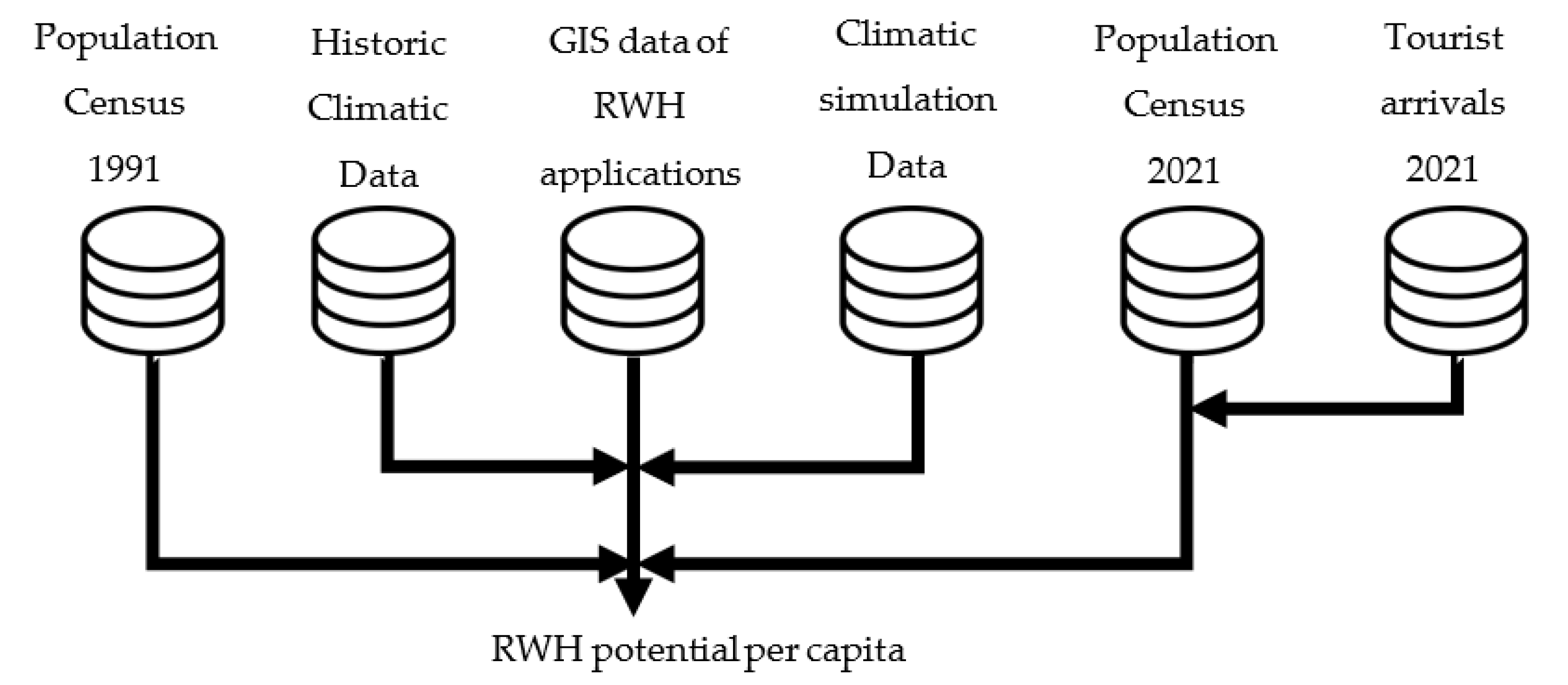
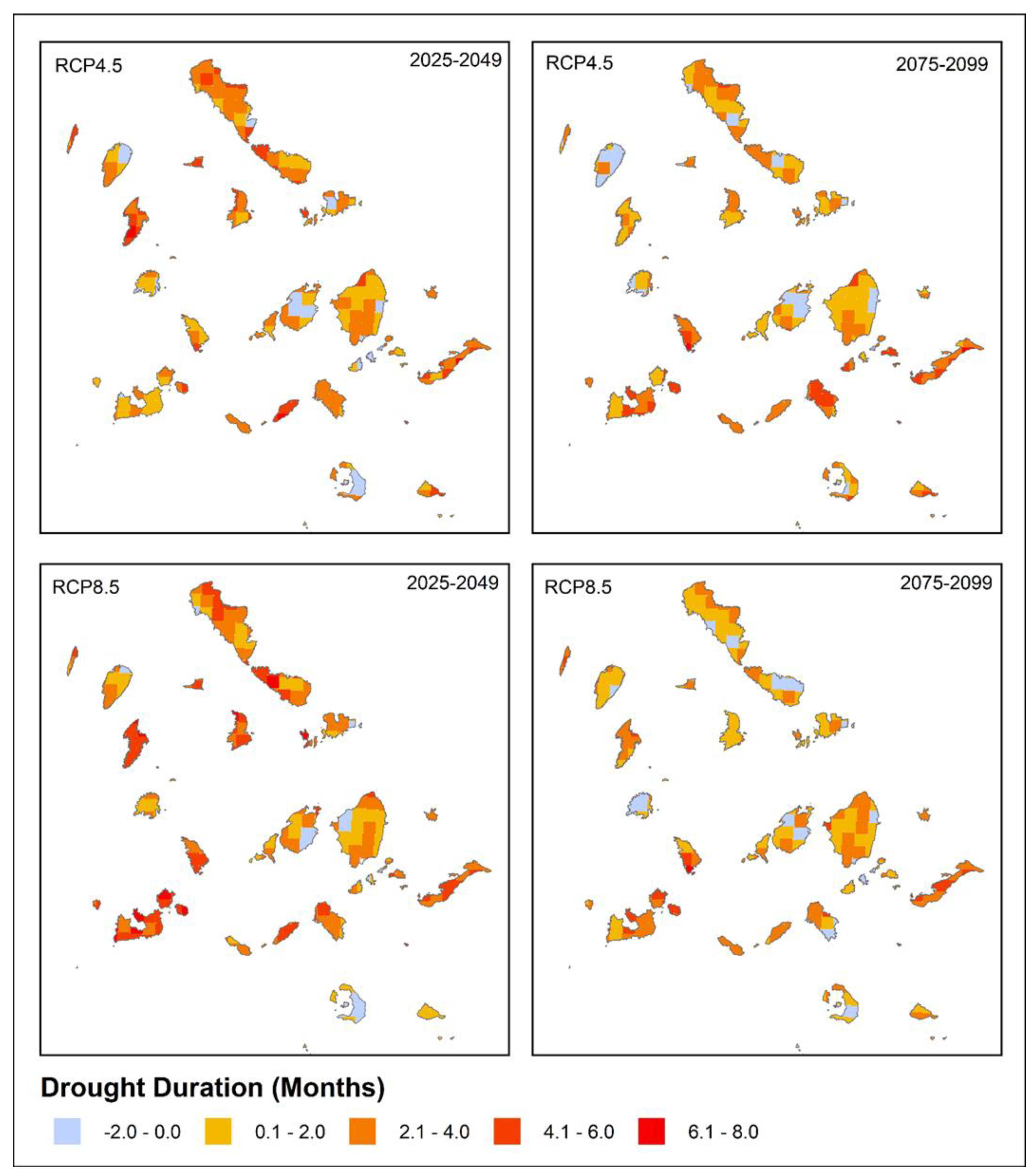
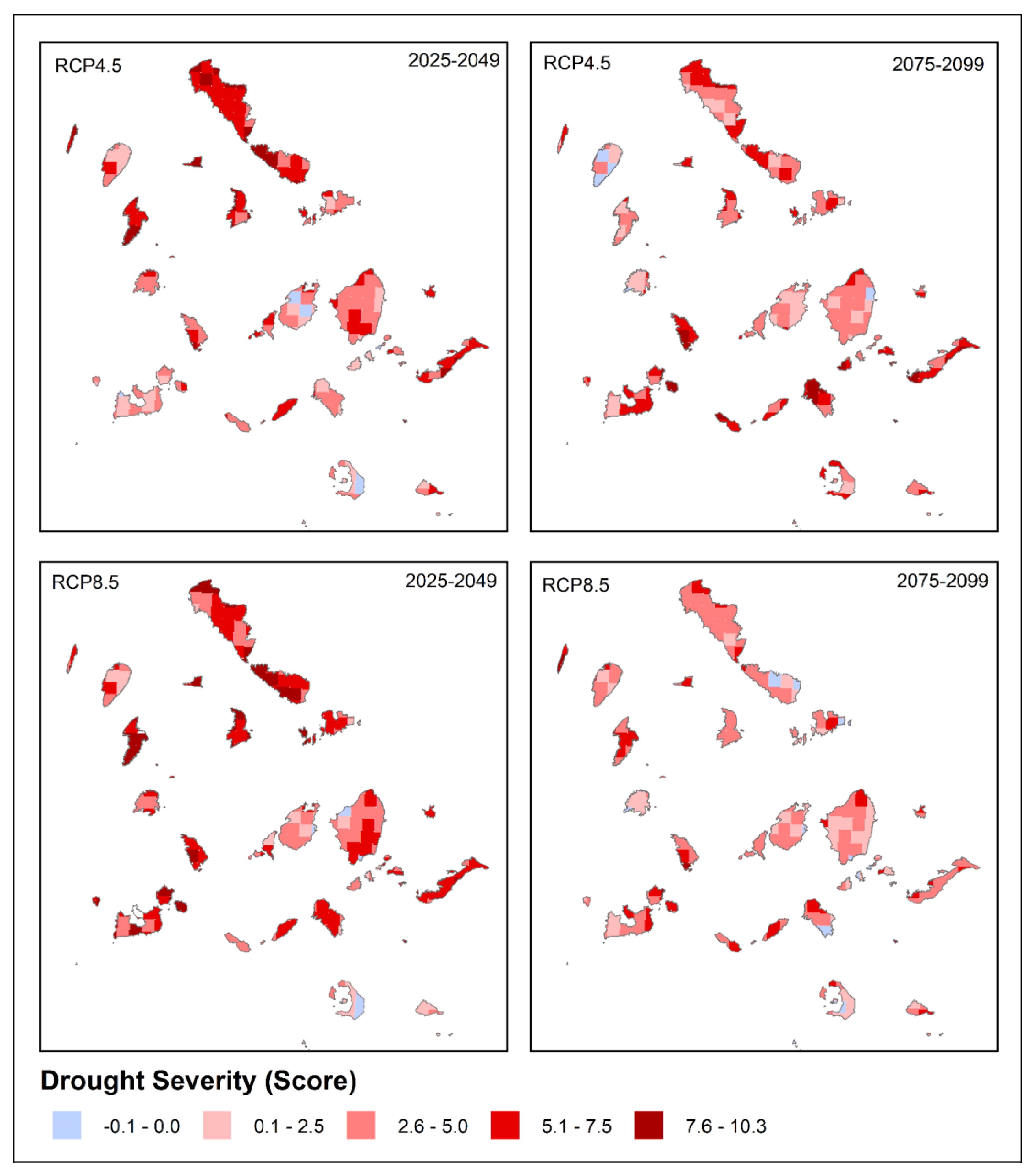
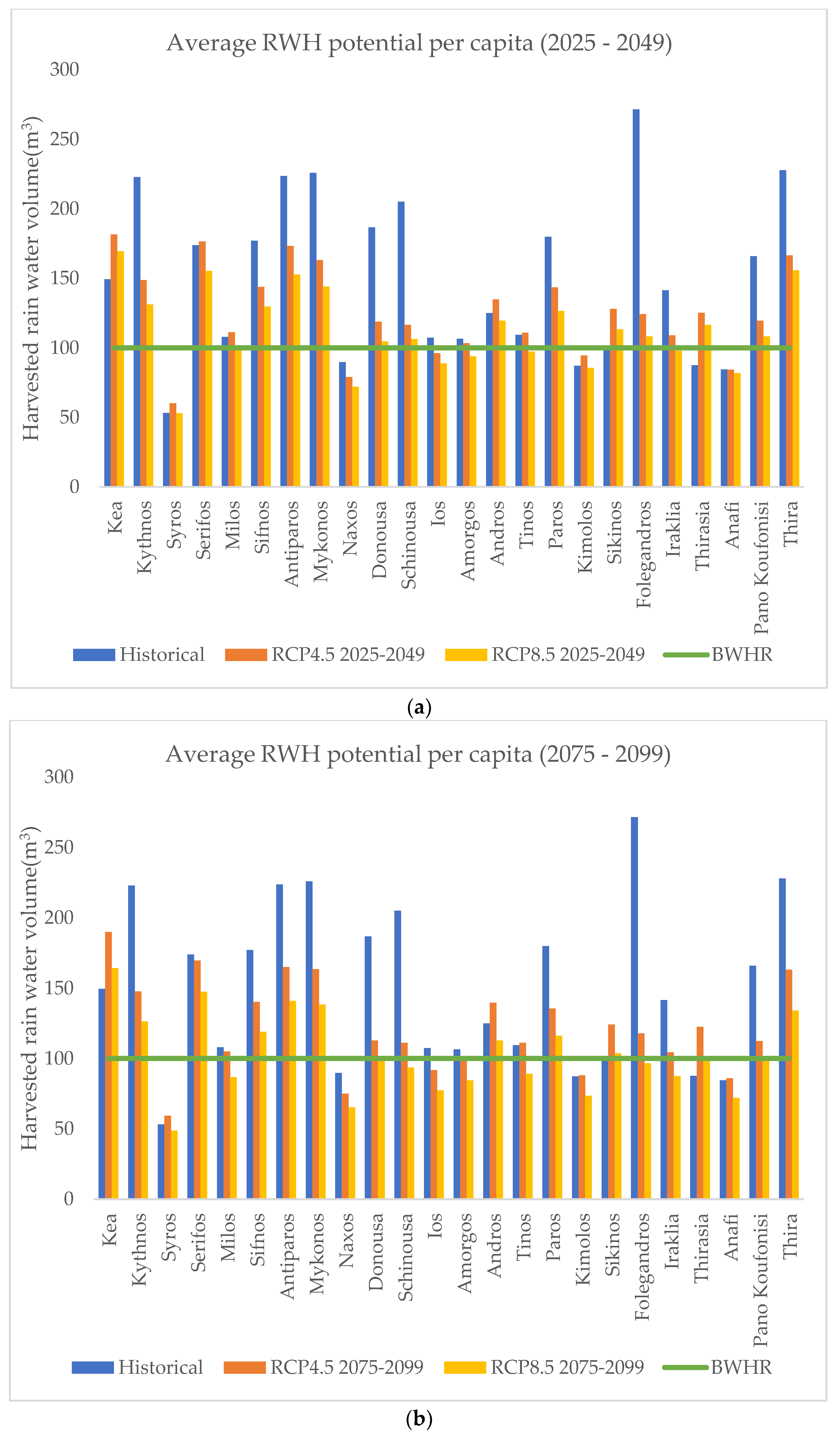
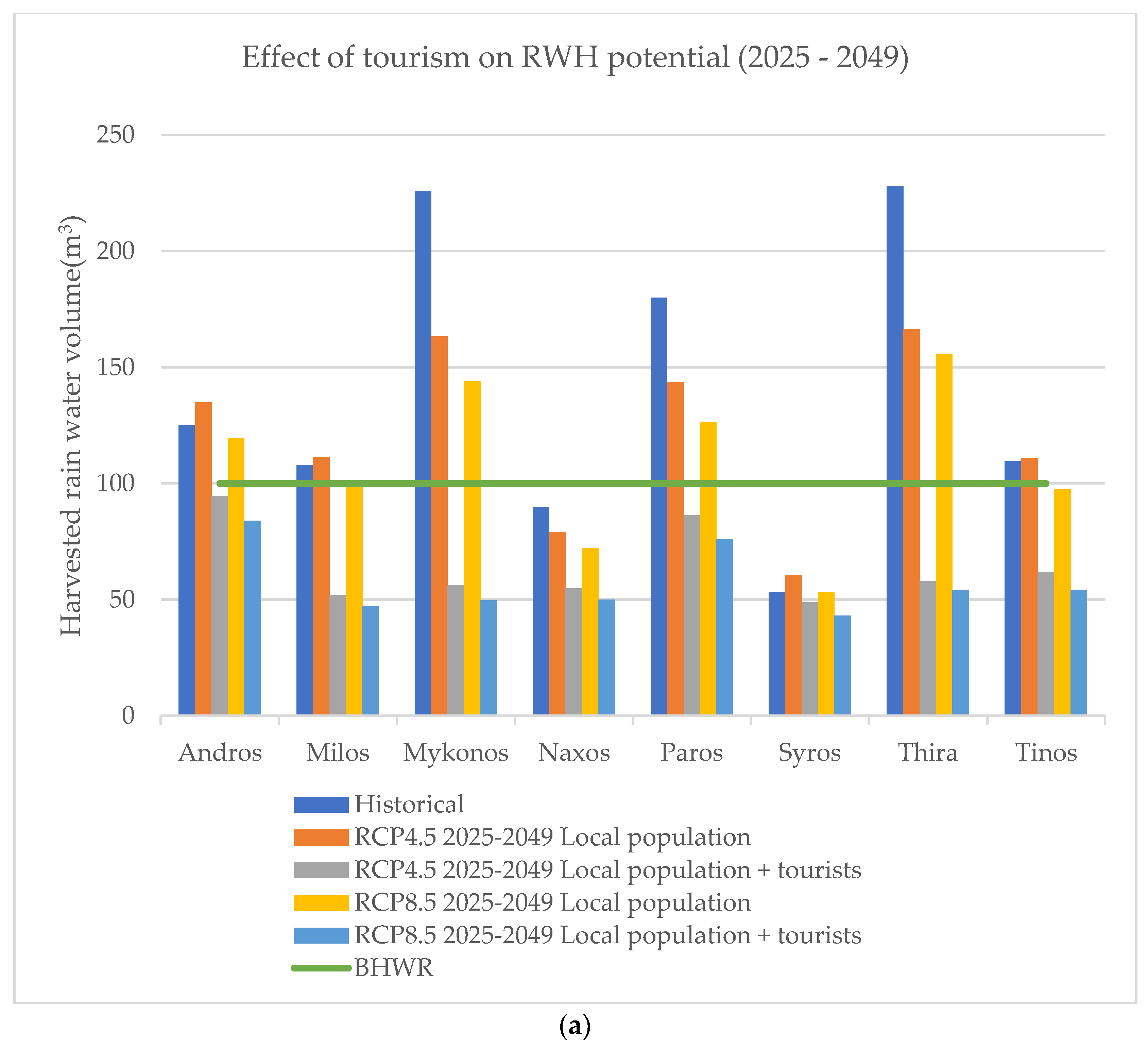
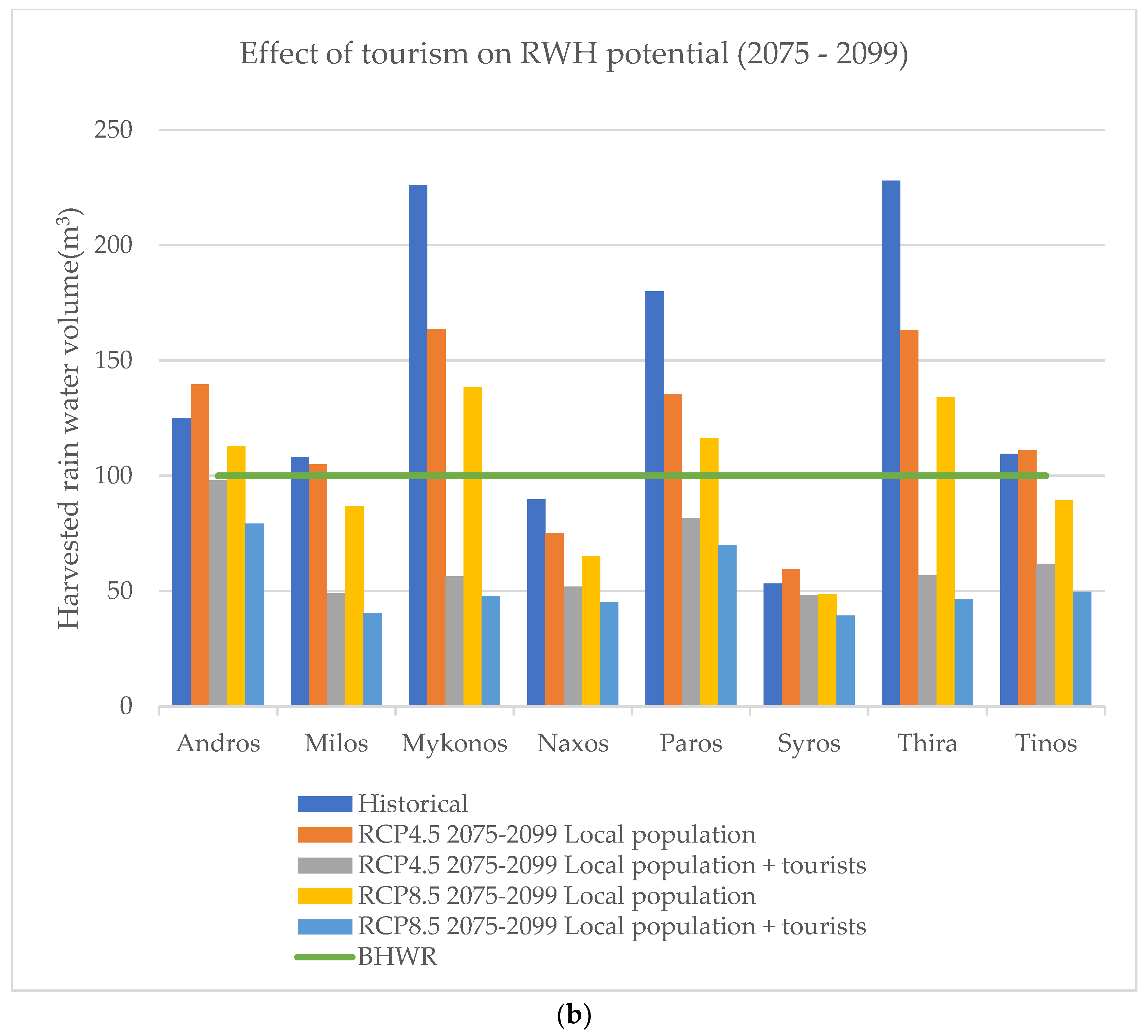

| Usage | Amount of Water Needed (L/p · year) |
|---|---|
| Drinking water | 2–4.5 |
| Sanitation | 20 |
| Bathing | 15–25 |
| Food preparation | 10–20 |
| Island | Total RWH Area (×1000 m2) | Total Island Area (×1000 m2) | Average Precipitation (m) | Total Volume of RWH (×1000 m3) | RWH (×1000 m3) | Rainwater Harvested (%) |
|---|---|---|---|---|---|---|
| Amorgos | 450.24 | 119,780.99 | 0.41 | 48,738.78 | 183.20 | 0.38% |
| Anafi | 72.95 | 38,170.89 | 0.11 | 4040.88 | 7.72 | 0.19% |
| Andros | 2286.06 | 378,769.54 | 0.89 | 337,781.03 | 2038.67 | 0.60% |
| Antiparos | 521.97 | 34,576.11 | 0.18 | 6180.30 | 93.30 | 1.51% |
| Donousa | 54.92 | 13,398.99 | 0.06 | 835.18 | 3.42 | 0.41% |
| Folegandros | 212.57 | 32,206.19 | 0.11 | 3692.58 | 24.37 | 0.66% |
| Ios | 506.62 | 108,571.87 | 0.32 | 34,205.69 | 159.61 | 0.47% |
| Iraklia | 46.45 | 18,139.70 | 0.08 | 1519.69 | 3.89 | 0.26% |
| Kea | 1035.82 | 131,706.72 | 0.28 | 37,196.30 | 292.53 | 0.79% |
| Kimolos | 197.28 | 37,490.25 | 0.14 | 5277.96 | 27.77 | 0.53% |
| Kythnos | 554.14 | 98,946.34 | 0.23 | 23,080.26 | 129.26 | 0.56% |
| Milos | 1282.98 | 157,628.99 | 0.44 | 69,468.68 | 565.42 | 0.81% |
| Mykonos | 3956.69 | 86,366.54 | 0.34 | 28,994.62 | 1328.32 | 4.58% |
| Naxos | 3375.22 | 428,632.97 | 0.83 | 356,915.77 | 2810.50 | 0.79% |
| Pano Koufonisi | 123.88 | 5712.14 | 0.06 | 337.96 | 7.33 | 2.17% |
| Paros | 4573.30 | 195,332.09 | 0.51 | 99,969.01 | 2340.57 | 2.34% |
| Schinousa | 71.70 | 8093.64 | 0.08 | 678.21 | 6.01 | 0.89% |
| Serifos | 478.86 | 72,396.06 | 0.29 | 21,159.41 | 139.96 | 0.66% |
| Sifnos | 944.19 | 76,225.17 | 0.25 | 18,755.46 | 232.32 | 1.24% |
| Sikinos | 79.44 | 41,316.10 | 0.12 | 4768.23 | 9.17 | 0.19% |
| Syros | 3083.19 | 84,262.41 | 0.26 | 22,021.73 | 805.78 | 3.66% |
| Thira | 6519.71 | 75,966.54 | 0.26 | 19,886.74 | 1706.75 | 8.58% |
| Thirasia | 98.31 | 9163.80 | 0.08 | 734.41 | 7.88 | 1.07% |
| Tinos | 1933.03 | 194,782.14 | 0.56 | 109,337.79 | 1085.08 | 0.99% |
| Island | Local Population | Tourist Arrivals | Normalized Population |
|---|---|---|---|
| Andros | 8883 | 276,000 | 12,664 |
| Milos | 5193 | 432,901 | 11,123 |
| Mykonos | 9802 | 1,361,196 | 28,449 |
| Naxos | 19,812 | 641,454 | 28,599 |
| Paros | 14,290 | 693,049 | 23,784 |
| Syros | 20,791 | 356,912 | 25,680 |
| Thira | 15,157 | 2,047,894 | 43,580 |
| Tinos | 8611 | 500,000 | 15,460 |
Disclaimer/Publisher’s Note: The statements, opinions and data contained in all publications are solely those of the individual author(s) and contributor(s) and not of MDPI and/or the editor(s). MDPI and/or the editor(s) disclaim responsibility for any injury to people or property resulting from any ideas, methods, instructions or products referred to in the content. |
© 2023 by the authors. Licensee MDPI, Basel, Switzerland. This article is an open access article distributed under the terms and conditions of the Creative Commons Attribution (CC BY) license (https://creativecommons.org/licenses/by/4.0/).
Share and Cite
Zarikos, I.; Politi, N.; Gounaris, N.; Karozis, S.; Vlachogiannis, D.; Sfetsos, A. Quantifying the Long-Term Performance of Rainwater Harvesting in Cyclades, Greece. Water 2023, 15, 3038. https://doi.org/10.3390/w15173038
Zarikos I, Politi N, Gounaris N, Karozis S, Vlachogiannis D, Sfetsos A. Quantifying the Long-Term Performance of Rainwater Harvesting in Cyclades, Greece. Water. 2023; 15(17):3038. https://doi.org/10.3390/w15173038
Chicago/Turabian StyleZarikos, Ioannis, Nadia Politi, Nikolaos Gounaris, Stelios Karozis, Diamando Vlachogiannis, and Athanasios Sfetsos. 2023. "Quantifying the Long-Term Performance of Rainwater Harvesting in Cyclades, Greece" Water 15, no. 17: 3038. https://doi.org/10.3390/w15173038
APA StyleZarikos, I., Politi, N., Gounaris, N., Karozis, S., Vlachogiannis, D., & Sfetsos, A. (2023). Quantifying the Long-Term Performance of Rainwater Harvesting in Cyclades, Greece. Water, 15(17), 3038. https://doi.org/10.3390/w15173038










